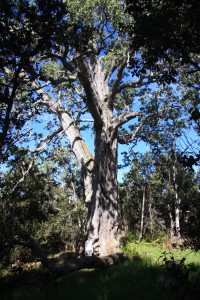Hawai‘i Big Tree Competition Accepting Nominations

Koa (Acacia koa) in Kona Hema Preserve, South Kona, Hawai‘i island. Image source: dlnr.hawaii.gov/forestry/info/big-tree/koa
The start of a new year also marks the beginning of the annual Hawai‘i Big Tree Competition. Nominations are being accepted for the 2016 spring season through Feb. 1.
Sponsored by the Department of Land and Natural Resources Division of Forestry and Wildlife and American Forests, the Big Tree program focuses attention on the largest trees of particular native species as a way to raise awareness about the importance of healthy trees and forests.
This national competition comes after the tragic falling of two previous Hawai‘i Big Tree champions: the coconut palm from Hawai‘i Kai, popularly known as “Coco,” and an ‘a‘ali‘i tree (Hopbush) from the Maui Botanical Gardens.
Both trees are being respectively preserved and/or reused at their locations.
In 2014, Coco was crowned the National Big Tree coconut species winner and the National Ultimate Big Tree winner among all candidate species after several weeks of intense online voting.
The public is invited to find new champions for these species, as well as the other 19 eligible species acknowledged by American Forests (see “Eligible Species” below).
Current Hawaiian Champions
Wiliwili (Erythrina sandwicensis) in Waikoloa dry forest, Hawai‘i island
(circumference: 186.96”) (height: 40’) (Crown Spread: 43.50’)
Olopua (Nestegis sandwicensis) in Pu‘u Wa‘awa‘a Forest Reserve, Hawai‘i island
(circumference: 204.52”) (Height: 32’) (Crown Spread: 42.58’)
Pāpalakēpau (Pisonia brunoniana) in Pu‘u Wa‘awa‘a Forest Reserve, Hawai‘i island
(circumference: 52.46”) (Height: 28’) (Crown Spread: 15.25’)
Māmane (Sophora chrysophylla) in Pu‘u Wa‘awa‘a Forest Reserve, Hawai‘i island
(circumference: 165) (Height: 24) (Crown Spread: 25.5’)
Kōlea lau nui (Myrsine lessertiana) in Pu‘u Wa‘awa‘a Forest Reserve, Hawai‘i island
(circumference: 85.14”) (height: 32’) (Crown Spread: 25.5’)
Koa (Acacia koa) in Kona Hema Preserve, South Kona, Hawai‘i island
(Circumference: 343”) (Height: 115’) (Crown Spread: 93’)
Hau (Hibiscus tiliaceus) in Hulihe‘e Palace, Kailua-Kona, Hawai‘i island
(Circumference: 110”) (Height: 20’) (Crown Spread: 25’)
Mānele (Sophora chrysophylla) in Volcanoes National Park, Hawai‘i island
(Circumference: 30”) (Height: 73’) (Crown Spread: 57’)
Eligible Species
The Hawai‘i Big Tree Competition does not have a champion for the following Hawaiian species that are eligible for the National Big Tree Program. Therefore, any tree nominated from the following list will likely be crowned National Champion.
Hawaiian Tree Name, Genus & Species
Lama, Diospyros sandwicensis
‘Ohi‘a ha, Syzygium sandwicense
‘Ohi‘a ai, Syzygium malaccense
Koki‘o ke‘oke‘o, Hibiscus arnottianus
Ma‘o hau hele, Hibiscus brackenridgei
Aloalo, Hibiscus clayii
Kāwa‘u, Ilex anomala
Nenelau, Rhus sandwicensis
Lonomea, Sapindus oahuensis
A‘e, Zanthoxylum oahuense
Wauke, Broussonetia papyrifera
To replace a current champion, the challenger tree must have more total points.
Total Points = Trunk Circumference (inches) + Height (feet) + ¼ Average Crown Spread (feet).
To nominate a tree, contact the Hawai‘i Big Tree Coordinator Krista Lizardi at (808) 587-0164 or [email protected] and provide the tree height, trunk circumference and average crown spread. Also, know your tree’s specific location (GPS coordinates are appreciated).
For more on the Hawai‘i Big Tree Program, go online.
For more on the National Big Tree Program go online.










